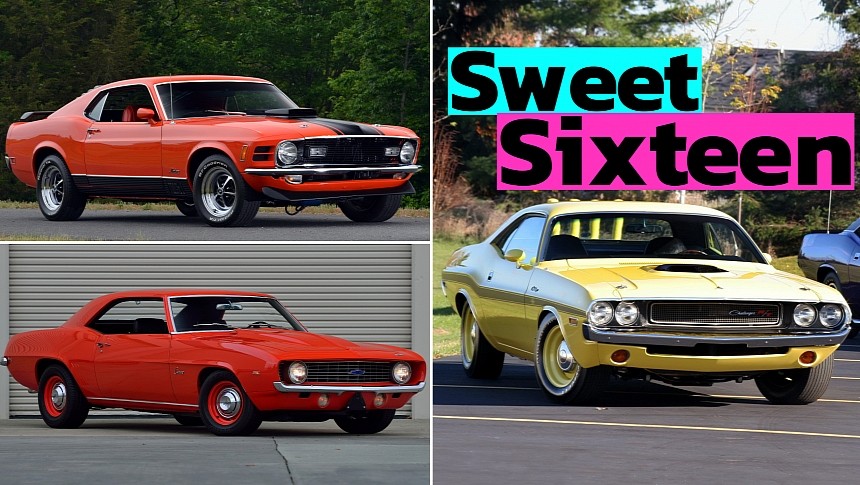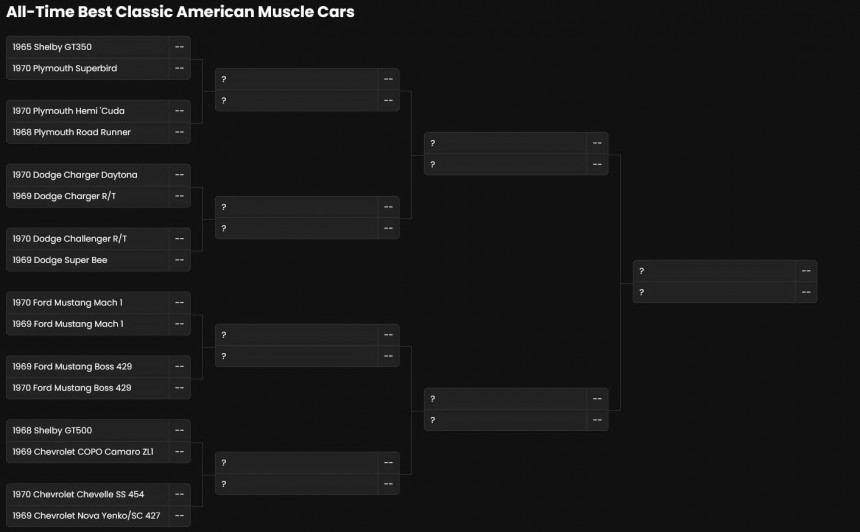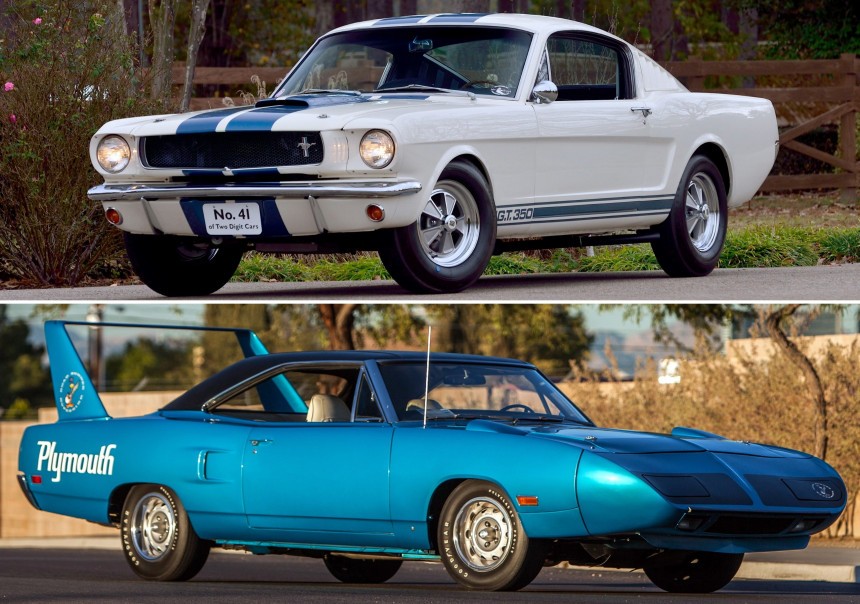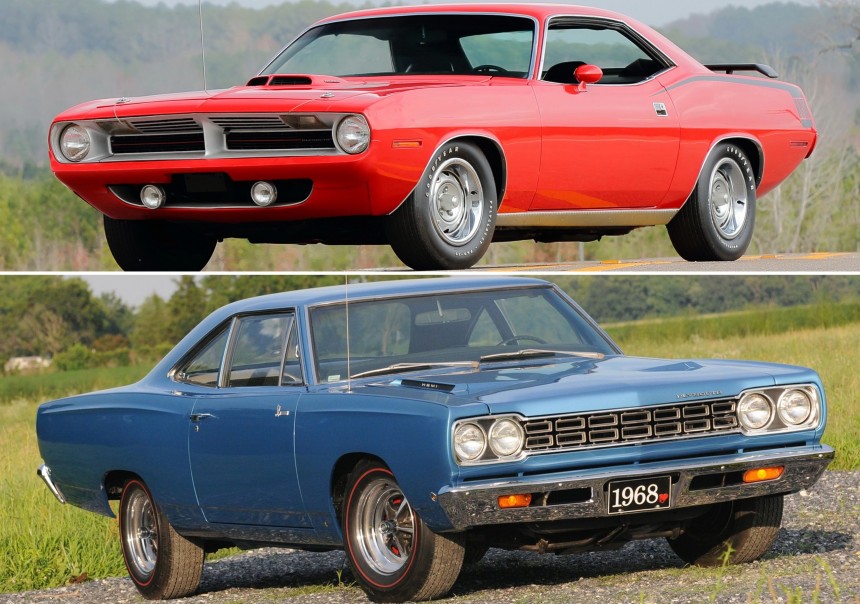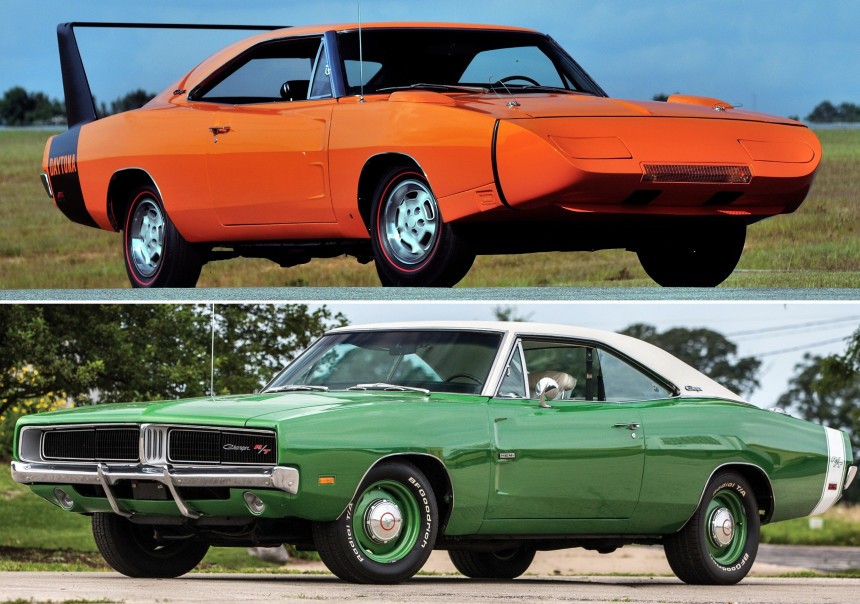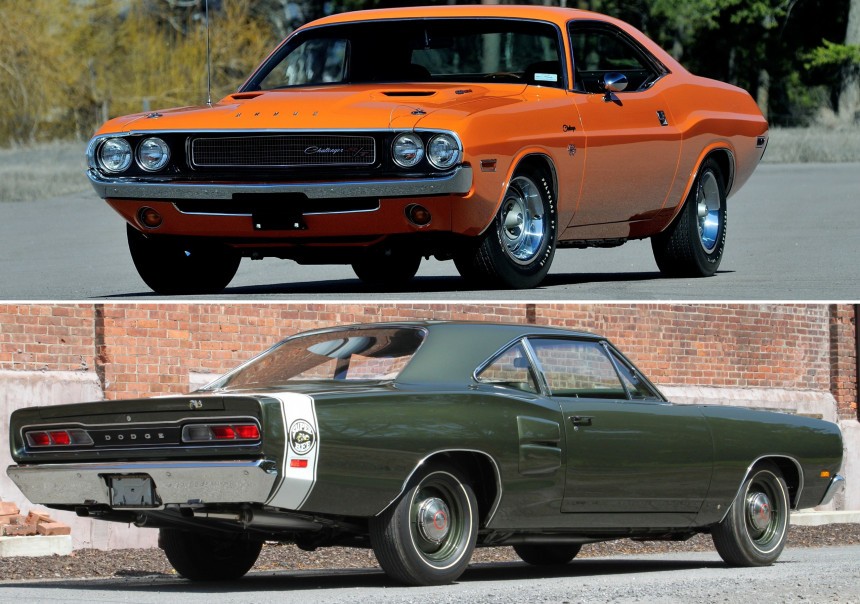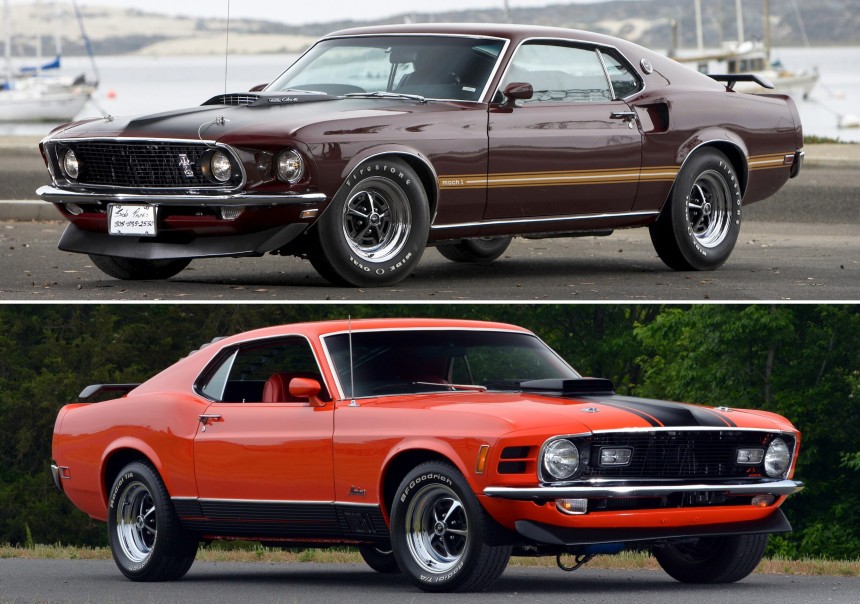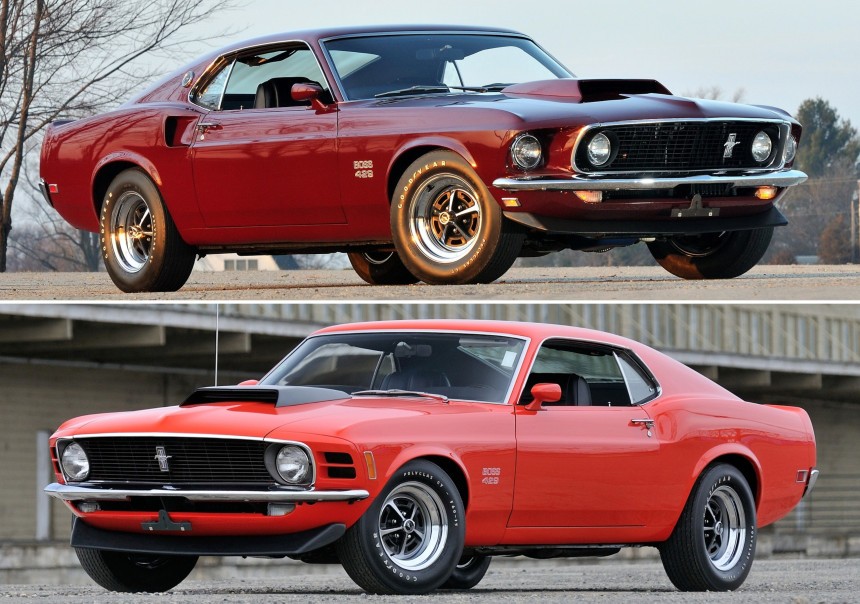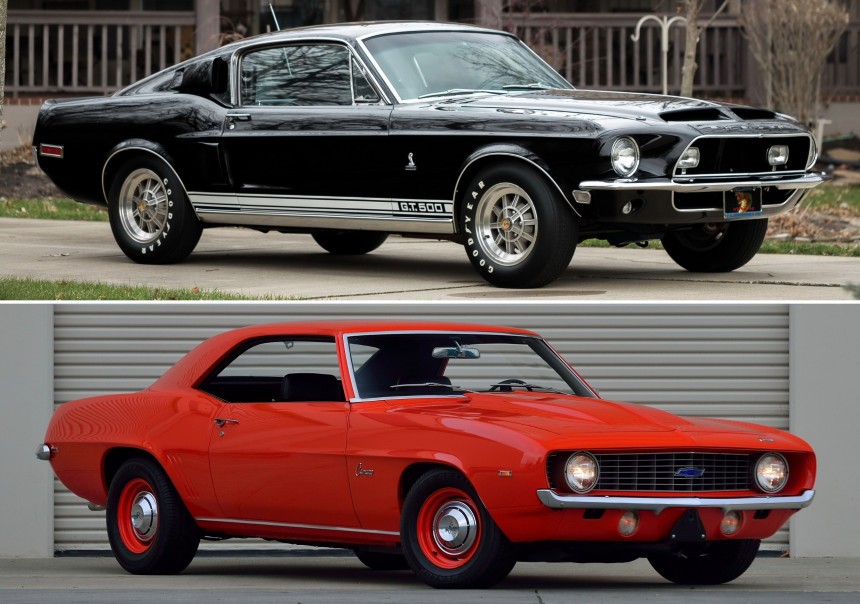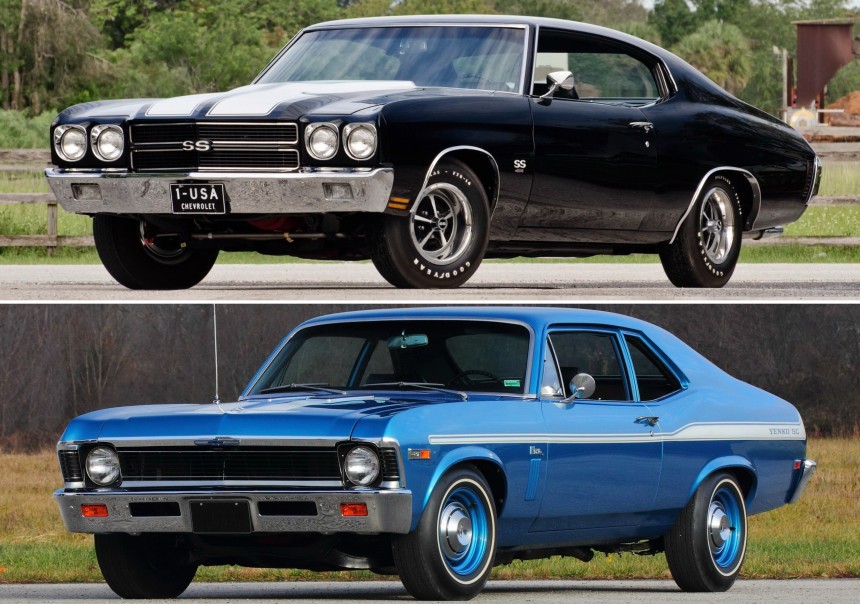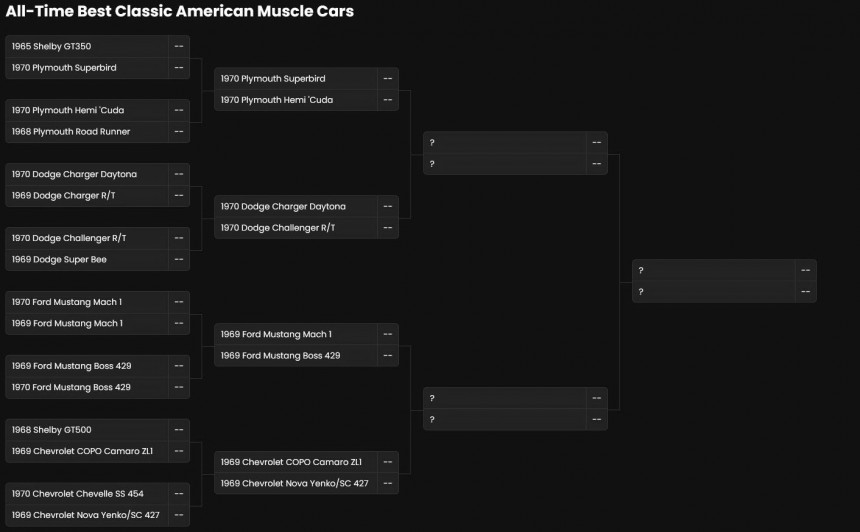We’re a little bit closer to determining the very best classic American muscle car ever made, after having already eliminated 16 models during last week’s Round of 32 knockout stage. This time around, we’re looking to cut down on some of the same-brand cars that made the Sweet Sixteen, which will be a challenge in and of itself.
What a journey this has been. The cars we’ve had to say goodbye to were all amazing, and some of them clearly didn’t deserve to get knocked out in the first round, but some of the choices were darn near impossible.
Let’s run through all the models that didn’t make the cut this week, in no particular order: 1966 Plymouth Satellite Street Hemi, 1970 Pontiac GT-37, 1969 Shelby GT500, 1969 Mercury Cougar Eliminator, 1968 Oldsmobile Hurst/Olds 442, 1970 Buick GSX Stage 1, 1968 Dodge Hemi Dart, 1964 Ford Thunderbolt, 1969 Pontiac GTO ‘Judge’, 1971 Ford Mustang Boss 351, 1970 Ford Torino GT Cobra, 1969 Chevrolet Chevelle SS 396, 1969 Pontiac Firebird Trans Am, 1967 Pontiac GTO, plus the 1970 and ‘71 Plymouth GTX.
Personally, I’m a little sour about the Thunderbolt and the Hemi Dart, both of which could have gone far in this “tournament”, had it not been for such difficult first-round matchups. The Thunderbolt had to go up against the 1969 Dodge Super Bee, while the Hemi Dart had the 1970 Challenger R/T as an opponent. That’s the very definition of tough.
Anyway, before we get right into this week’s matchups, let’s check out the field one more time and see who’s going up against who.
As you ca see, we’ve got a total of eight battles, with maybe one or two of them being seemingly straightforward. Otherwise, it’s impossible decision after impossible decision. But that’s not going to stop us from going forward.
Let’s dance.
Some might argue that the original Shelby GT350 isn’t that much of a muscle car, and I understand why you’d say that. Its 289 ci V8 engine is only good for 306 horsepower and 329 lb-ft of torque. The flip side of that argument is that they weren’t particularly heavy either, and in the right conditions, they could really put some hair on your chest, if you know what I mean.
Everything about the GT350 was hardcore as far as that era was concerned. The side-exit dual exhaust with glasspack mufflers, the rear seat delete, the 4-speed manual, the 130 mph-rated Goodyear rubber, the 715-cfm Holley carburetor, larger drums at the rear, and so on.
These Mustangs could corner with a lot more precision than their factory-standard doppelgangers, so nobody can accuse them of being all show and no go.
It’s no wonder they’ve gotten to be so iconic – these were the first-ever Mustangs modified by Carroll Shelby himself. Buying one today (in good condition) will set you back hundreds of thousands of dollars, so saying that this car casts a gigantic shadow would be an understatement.
What’s funny is that the Plymouth Superbird isn’t all that different from the GT350, from an engineering philosophy standpoint. These too were designed with racing in mind, featuring that stunning aerodynamic nose, a gigantic rear wing, and big-block V8 engines like the 426 Hemi with its 425 horsepower and 490 lb-ft of torque.
These cars were so awesome, they lured Richard Petty back to Plymouth after having left the team in favor of Ford in late 1968.
The Superbird is an icon, and it can tick just about any box the Shelby GT350 can, including value – these are in no way cheaper to purchase today than an original Shelby-tuned Mustang.
Now, the question is, which of the two would you rather own and not only that, but drive? Probably the Plymouth, right? It’s more of a muscle car, and it looks more imposing, which can be enough for most people.
Winner: 1970 Plymouth Superbird
If you’re going by power, let’s just get it out of the way now – the ‘70 Hemi ‘Cuda and the ‘68 Road Runner can both field 425 hp / 490 lb-ft of torque courtesy of their 426 ci (7.0L) Hemi V8 engines.
We can’t make this about performance because both cars are sufficient in that department. We can, however, make it about value and icon status, which is where the E-body Barracuda should have an upper hand, especially the so-called Hemi ‘Cuda. You can buy stunning Road Runners for under $100,000, and immaculate ones for way more, yes. The Hemi ‘Cuda, on the other hand, will rarely dip under $100k.
On average, they’re rarer and more expensive. Some might argue that they’re also better looking, although we could go either way as far as looks are concerned – it really depends what type of design language you prefer.
Personally, I think the ‘Cuda just has more going for it, and once you factor in that Hemi V8 engine (not that the AAR ‘Cuda is anything to laugh at), you end up with what is arguably one of the low-key greatest muscle cars ever produced, and one that any serious collector would love to put in his or her garage.
Besides, a win for the flagship ‘Cuda sets up an amazing bout for the Elite Eight, at least on this top part of the bracket.
Winner: 1970 Plymouth Hemi ‘Cuda
We really should drop one of these two, because there would have been no sense in both of them advancing to the Elite Eight anyway. I think this one might be easier than expected, as much as I love the good old regular Charger R/T, freaking General Lee itself.
I also can’t begin to express how much I appreciate the 1969 Charger in terms of how it looks. I think it’s one of the best-looking American classics ever, maybe even Top 3, and cars such as the Daytona or the Superbird for that matter, are more of an acquired taste from a visual standpoint. They look bonkers, yes, but do they really have enough style?
Having said that, this list can’t be all about me and my personal preferences. So, assuming identical engines for both, meaning 426 ci Hemi V8 units with 425 horsepower apiece... man oh man, this is so annoyingly tough – to be fair, the Daytona is both quicker and faster, if you get the distinction.
I would have loved to see the regular second-generation Charger through, but the Daytona is way more valuable today, and it’s got genuine motorsport roots. It was the first NASCAR stock car to break the 200 mph (322 kph) mark at Talladega in 1970, so owning one today can’t be anything but a dream come true.
For the record, I’d take a ‘General Lee’ over a Daytona any day of the week, but that’s because I’m not a collector.
Winner: 1970 Dodge Charger Daytona
Dodge had high hopes for the Super Bee, which was based on the two-door coupe variant of the Coronet. The carmaker was hoping to replicate the success of the Plymouth Road Runner, and while it never sold as well, you could never fault it for what it was – a sublime muscle car.
There was no shortage of awesome specs to choose from. From the “six-pack” to the Hemi, you were more than covered in terms of horsepower. The former was a 440 ci V8 engine, with 390 hp, while the latter was the 426 ci Hemi V8 with its 425 horsepower.
By Comparison, the Challenger offered more engine options, to go with a more compact body in terms of size, which would give it the edge in terms of handling.
You could get the flagship spec Challenger R/T with either a 383 ci Magnum V8, a 440 ci Magnum V8, the 440 ci “six-pack”, or the 426 ci Hemi V8. These babies were also available as convertibles (not just hardtops), which isn’t vital for our comparison, but it’s worth mentioning. Frankly, I could go either way, because both of these were tremendous.
I think icon status is fairly similar between the two, and so are their values on the used car market. I would give the Super Bee the upper hand in terms of looks, but I think that’s the only category where it flat out wins.
Winner: 1970 Dodge Challenger R/T
There are plenty of subtle and no-so-subtle differences between the 1969 and the 1970 model year Mustangs, and we’ll need to run through most (if not all) of them to firmly rule in favor of one or the other.
I think most people will argue that the 1969 variants are the best-looking Mustangs of all time, the quintessential Mustangs, if you will. That’s when Ford decided to add more road presence by increasing overall length and width. The Blue Oval also went with a quad headlight setup for the front fascia, which some still consider controversial, but let’s be real, it’s an iconic look. Maybe they had issues with it back in the late 69s, but this is 2023 and if it’s good enough for John Wick, it’ll be good enough for us.
As far as the Mach 1 is concerned, 1969 holds a lot of weight because it was the year in which this specification made its debut, with those distinctive reflective stripes, matte-black hood, air scoops, cable and pin tiedowns, rear window louvers, plus quite a few mods for the interior as well.
People loved the Mach 1 right off the bat, and how could they not? As for the engine of choice, that should be the 428 ci Cobra Jet or the Super Cobra Jet V8, offering 335 horsepower and 440 lb-ft of torque.
What happened the following year was that Ford took the ‘69 Mach 1 and basically kept just the grille-mounted headlights, added fins to the outside of the fascia, and then made the whole car look a bit less aggressive. They even removed the rear air scoops and flattened the taillight panel, which used to be concave.
Look, nothing against the ‘70 Mach 1, I love them to death, but with all things being equal in terms of performance (and they are), there’s only one way this battle can end.
Winner: 1969 Ford Mustang Mach 1
We’ve got to drop some more of these Mustangs and it’s a good thing we can do it in this round, as opposed to either of the next two. This time, we’ve got to decide between the ‘69 and ‘70 Boss 429 variants, the ones built for NASCAR homologation.
These cars were only available during that specific two-year period, and aside from the change in appearance we just mentioned in the Mach 1 battle from earlier, there were other notable differences too. For example, 1970MY Boss 429 Mustangs had black hood scoops instead of body-color ones, and they came in a wider range of colors – and cool ones too, like Grabber Orange, Grabber Blue and Grabber Green.
Then, you had the Hurst shifter inside the 1970 model year car, instead of the regular Ford shifter – so props for that. Meanwhile, if you’re a collector, you might appreciate that Ford built less Boss 429 models in 1970 than it did in 1969, making the newer car technically rarer.
In terms of powertrains, both came with 429 ci V8 units, good for 375 horsepower and 450 lb-ft of torque, although the 1969MY car’s hydraulic lifter camshaft was swapped for a mechanical lifter one. This had no impact on performance though – it was merely a simpler design.
Yet another hard choice, but this is one of those cases where you’ve got to go with the consensus. Besides, it’s not like you didn’t already know which way you were leaning.
Winner: 1969 Ford Mustang Boss 429
How do we even begin to quantify what these two cars meant for their respective fan bases, let alone car enthusiasts in general?
One is an icon, the other a bit of a dark horse, but one that might even go all the way in this competition, should it win this round. Let’s start with the Shelby first, which at its best, would have been available with either 355 horsepower or 335 horsepower, depending on which specification you opted for.
Either way, we’re talking Cobra Jet power, which as one of my colleagues pointed out, is something you’d find in several other vehicles, so not that original of an engine. On the opposite side of the spectrum lies the COPO Camaro ZL1, arguably the most desirable Camaro in history – a race car for the road.
These were rare, and I do mean rare. Power came from 427 ci V8 units with 430 horsepower and 450 lb-ft of torque, although some believe the true output was more in the vicinity of 500 horsepower. Only 69 cars were commissioned for the 1969 model year (fittingly), and if you want one today, prepare to pay at least twice as much as you would on a ‘68 Shelby GT500. These Camaros can easily set you back half a mil, and in some cases, a lot more.
So, while I’m not a huge fan of the first-gen Camaro in terms of its styling, the COPO ZL1 is too much of a beast to take a backseat to any Shelby-tuned Mustang.
Winner: 1969 Chevrolet COPO Camaro ZL1
Both cars dispatched a couple of Plymouths to the next world during last week’s tournament and did so with relative ease. I knew immediately that choosing between them would be nearly impossible, because they are ridiculously evenly matched.
You can flip a coin, literally. I even surfed some fan pages (initially I wanted to avoid doing that, for the sake of objectivity), and even there, people seemed to be split. Some that had owned Chevelles in the past called it in favor of the Chevelle, while Nova fans would usually go with the Nova. Meanwhile, impartial parties tend to struggle with this choice.
Let’s run through the numbers again. The ‘70 Chevelle SS 454 LS6 (we’re talking the optional LS6 V8), is good for 450 horsepower and 500 lb-ft of torque. This was easily one of the fastest muscle cars of its era.
The Chevy Nova Yenko/SC, on the other hand, comes with a 427 ci V8, packing 425 horsepower and 460 lb-ft of torque. I couldn’t tell you which would win a drag race with 100% certainty. The Chevelle had more power and torque, but it’s the heavier car.
Then there’s the fact that one is a heck of a lot rarer than the other. Only 37 Yenko/SC Novas were ever produced, and if I may, I think it’s the better-looking car as far as these two are concerned. It’s not a landslide win in that department, but the Nova will usually sneak up on you with its low-key awesome appearance.
It was super tough, but a choice has to be made and here it is.
Winner: 1969 Chevrolet Nova Yenko/SC
Tune in next week for what’s bound to be a crazy round with only eight cars left in the competition.
Let’s run through all the models that didn’t make the cut this week, in no particular order: 1966 Plymouth Satellite Street Hemi, 1970 Pontiac GT-37, 1969 Shelby GT500, 1969 Mercury Cougar Eliminator, 1968 Oldsmobile Hurst/Olds 442, 1970 Buick GSX Stage 1, 1968 Dodge Hemi Dart, 1964 Ford Thunderbolt, 1969 Pontiac GTO ‘Judge’, 1971 Ford Mustang Boss 351, 1970 Ford Torino GT Cobra, 1969 Chevrolet Chevelle SS 396, 1969 Pontiac Firebird Trans Am, 1967 Pontiac GTO, plus the 1970 and ‘71 Plymouth GTX.
Personally, I’m a little sour about the Thunderbolt and the Hemi Dart, both of which could have gone far in this “tournament”, had it not been for such difficult first-round matchups. The Thunderbolt had to go up against the 1969 Dodge Super Bee, while the Hemi Dart had the 1970 Challenger R/T as an opponent. That’s the very definition of tough.
Anyway, before we get right into this week’s matchups, let’s check out the field one more time and see who’s going up against who.
Let’s dance.
1965 Shelby GT350 vs. 1970 Plymouth Superbird
Everything about the GT350 was hardcore as far as that era was concerned. The side-exit dual exhaust with glasspack mufflers, the rear seat delete, the 4-speed manual, the 130 mph-rated Goodyear rubber, the 715-cfm Holley carburetor, larger drums at the rear, and so on.
These Mustangs could corner with a lot more precision than their factory-standard doppelgangers, so nobody can accuse them of being all show and no go.
It’s no wonder they’ve gotten to be so iconic – these were the first-ever Mustangs modified by Carroll Shelby himself. Buying one today (in good condition) will set you back hundreds of thousands of dollars, so saying that this car casts a gigantic shadow would be an understatement.
What’s funny is that the Plymouth Superbird isn’t all that different from the GT350, from an engineering philosophy standpoint. These too were designed with racing in mind, featuring that stunning aerodynamic nose, a gigantic rear wing, and big-block V8 engines like the 426 Hemi with its 425 horsepower and 490 lb-ft of torque.
These cars were so awesome, they lured Richard Petty back to Plymouth after having left the team in favor of Ford in late 1968.
The Superbird is an icon, and it can tick just about any box the Shelby GT350 can, including value – these are in no way cheaper to purchase today than an original Shelby-tuned Mustang.
Now, the question is, which of the two would you rather own and not only that, but drive? Probably the Plymouth, right? It’s more of a muscle car, and it looks more imposing, which can be enough for most people.
Winner: 1970 Plymouth Superbird
1970 Plymouth Hemi ‘Cuda vs. 1968 Plymouth Road Runner
We can’t make this about performance because both cars are sufficient in that department. We can, however, make it about value and icon status, which is where the E-body Barracuda should have an upper hand, especially the so-called Hemi ‘Cuda. You can buy stunning Road Runners for under $100,000, and immaculate ones for way more, yes. The Hemi ‘Cuda, on the other hand, will rarely dip under $100k.
On average, they’re rarer and more expensive. Some might argue that they’re also better looking, although we could go either way as far as looks are concerned – it really depends what type of design language you prefer.
Personally, I think the ‘Cuda just has more going for it, and once you factor in that Hemi V8 engine (not that the AAR ‘Cuda is anything to laugh at), you end up with what is arguably one of the low-key greatest muscle cars ever produced, and one that any serious collector would love to put in his or her garage.
Besides, a win for the flagship ‘Cuda sets up an amazing bout for the Elite Eight, at least on this top part of the bracket.
Winner: 1970 Plymouth Hemi ‘Cuda
1970 Dodge Charger Daytona vs. 1969 Dodge Charger R/T
I also can’t begin to express how much I appreciate the 1969 Charger in terms of how it looks. I think it’s one of the best-looking American classics ever, maybe even Top 3, and cars such as the Daytona or the Superbird for that matter, are more of an acquired taste from a visual standpoint. They look bonkers, yes, but do they really have enough style?
Having said that, this list can’t be all about me and my personal preferences. So, assuming identical engines for both, meaning 426 ci Hemi V8 units with 425 horsepower apiece... man oh man, this is so annoyingly tough – to be fair, the Daytona is both quicker and faster, if you get the distinction.
I would have loved to see the regular second-generation Charger through, but the Daytona is way more valuable today, and it’s got genuine motorsport roots. It was the first NASCAR stock car to break the 200 mph (322 kph) mark at Talladega in 1970, so owning one today can’t be anything but a dream come true.
For the record, I’d take a ‘General Lee’ over a Daytona any day of the week, but that’s because I’m not a collector.
Winner: 1970 Dodge Charger Daytona
1970 Dodge Challenger R/T vs. 1969 Dodge Super Bee
There was no shortage of awesome specs to choose from. From the “six-pack” to the Hemi, you were more than covered in terms of horsepower. The former was a 440 ci V8 engine, with 390 hp, while the latter was the 426 ci Hemi V8 with its 425 horsepower.
By Comparison, the Challenger offered more engine options, to go with a more compact body in terms of size, which would give it the edge in terms of handling.
You could get the flagship spec Challenger R/T with either a 383 ci Magnum V8, a 440 ci Magnum V8, the 440 ci “six-pack”, or the 426 ci Hemi V8. These babies were also available as convertibles (not just hardtops), which isn’t vital for our comparison, but it’s worth mentioning. Frankly, I could go either way, because both of these were tremendous.
I think icon status is fairly similar between the two, and so are their values on the used car market. I would give the Super Bee the upper hand in terms of looks, but I think that’s the only category where it flat out wins.
Winner: 1970 Dodge Challenger R/T
1970 Ford Mustang Mach 1 vs. 1969 Ford Mustang Mach 1
I think most people will argue that the 1969 variants are the best-looking Mustangs of all time, the quintessential Mustangs, if you will. That’s when Ford decided to add more road presence by increasing overall length and width. The Blue Oval also went with a quad headlight setup for the front fascia, which some still consider controversial, but let’s be real, it’s an iconic look. Maybe they had issues with it back in the late 69s, but this is 2023 and if it’s good enough for John Wick, it’ll be good enough for us.
As far as the Mach 1 is concerned, 1969 holds a lot of weight because it was the year in which this specification made its debut, with those distinctive reflective stripes, matte-black hood, air scoops, cable and pin tiedowns, rear window louvers, plus quite a few mods for the interior as well.
People loved the Mach 1 right off the bat, and how could they not? As for the engine of choice, that should be the 428 ci Cobra Jet or the Super Cobra Jet V8, offering 335 horsepower and 440 lb-ft of torque.
What happened the following year was that Ford took the ‘69 Mach 1 and basically kept just the grille-mounted headlights, added fins to the outside of the fascia, and then made the whole car look a bit less aggressive. They even removed the rear air scoops and flattened the taillight panel, which used to be concave.
Look, nothing against the ‘70 Mach 1, I love them to death, but with all things being equal in terms of performance (and they are), there’s only one way this battle can end.
Winner: 1969 Ford Mustang Mach 1
1969 Ford Mustang Boss 429 vs. 1970 Ford Mustang Boss 429
These cars were only available during that specific two-year period, and aside from the change in appearance we just mentioned in the Mach 1 battle from earlier, there were other notable differences too. For example, 1970MY Boss 429 Mustangs had black hood scoops instead of body-color ones, and they came in a wider range of colors – and cool ones too, like Grabber Orange, Grabber Blue and Grabber Green.
Then, you had the Hurst shifter inside the 1970 model year car, instead of the regular Ford shifter – so props for that. Meanwhile, if you’re a collector, you might appreciate that Ford built less Boss 429 models in 1970 than it did in 1969, making the newer car technically rarer.
In terms of powertrains, both came with 429 ci V8 units, good for 375 horsepower and 450 lb-ft of torque, although the 1969MY car’s hydraulic lifter camshaft was swapped for a mechanical lifter one. This had no impact on performance though – it was merely a simpler design.
Yet another hard choice, but this is one of those cases where you’ve got to go with the consensus. Besides, it’s not like you didn’t already know which way you were leaning.
Winner: 1969 Ford Mustang Boss 429
1968 Shelby GT500 vs. 1969 Chevrolet COPO Camaro ZL1
One is an icon, the other a bit of a dark horse, but one that might even go all the way in this competition, should it win this round. Let’s start with the Shelby first, which at its best, would have been available with either 355 horsepower or 335 horsepower, depending on which specification you opted for.
Either way, we’re talking Cobra Jet power, which as one of my colleagues pointed out, is something you’d find in several other vehicles, so not that original of an engine. On the opposite side of the spectrum lies the COPO Camaro ZL1, arguably the most desirable Camaro in history – a race car for the road.
These were rare, and I do mean rare. Power came from 427 ci V8 units with 430 horsepower and 450 lb-ft of torque, although some believe the true output was more in the vicinity of 500 horsepower. Only 69 cars were commissioned for the 1969 model year (fittingly), and if you want one today, prepare to pay at least twice as much as you would on a ‘68 Shelby GT500. These Camaros can easily set you back half a mil, and in some cases, a lot more.
So, while I’m not a huge fan of the first-gen Camaro in terms of its styling, the COPO ZL1 is too much of a beast to take a backseat to any Shelby-tuned Mustang.
Winner: 1969 Chevrolet COPO Camaro ZL1
1970 Chevrolet Chevelle SS 454 LS6 vs. 1969 Chevrolet Nova Yenko/SC
You can flip a coin, literally. I even surfed some fan pages (initially I wanted to avoid doing that, for the sake of objectivity), and even there, people seemed to be split. Some that had owned Chevelles in the past called it in favor of the Chevelle, while Nova fans would usually go with the Nova. Meanwhile, impartial parties tend to struggle with this choice.
Let’s run through the numbers again. The ‘70 Chevelle SS 454 LS6 (we’re talking the optional LS6 V8), is good for 450 horsepower and 500 lb-ft of torque. This was easily one of the fastest muscle cars of its era.
The Chevy Nova Yenko/SC, on the other hand, comes with a 427 ci V8, packing 425 horsepower and 460 lb-ft of torque. I couldn’t tell you which would win a drag race with 100% certainty. The Chevelle had more power and torque, but it’s the heavier car.
Then there’s the fact that one is a heck of a lot rarer than the other. Only 37 Yenko/SC Novas were ever produced, and if I may, I think it’s the better-looking car as far as these two are concerned. It’s not a landslide win in that department, but the Nova will usually sneak up on you with its low-key awesome appearance.
It was super tough, but a choice has to be made and here it is.
Winner: 1969 Chevrolet Nova Yenko/SC
